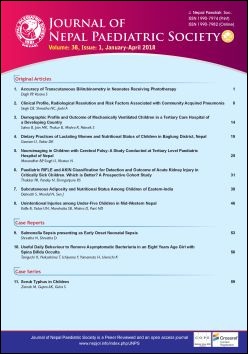Paediatric RIFLE and AKIN Classification for Detection and Outcome of Acute Kidney Injury in Critically Sick Children. Which is Better? A Prospective Cohort Study
DOI:
https://doi.org/10.3126/jnps.v38i1.19767Keywords:
Acute Kidney Injury, Acute Kidney Injury Network, Pediatric intensive care unit, Pediatric RIFLE, mortalityAbstract
Introduction: Acute Kidney Injury (AKI) is becoming increasingly common in both developed and developing countries with significant morbidity and mortality. However, the precise incidence of AKI in children is not well known due to lack of uniformity in various definitions of AKI. This study was carried out to compare incidence of AKI using two different definitions-pRIFLE and AKIN.
Material and Methods: This was a prospective cohort study conducted in the paediatric ICU of a tertiary care government hospital attached to a Medical College of Central Gujarat, India. Total 115 critically ill paediatric patients aged one month to 12 years were included in the study. Serum Creatinine (SCr) levels were tested and Glomerular filtration rate (GFR) was calculated using the Schwartz formula at 0, 6, 12, 24 and 48 hours of admission. Patients were assessed for AKI using AKIN and pRIFLE classification.
Results: Incidence of AKI was 80% and 66.9% in critically ill children, as classified by pRIFLE and AKIN classification respectively. Paediatric RIFLE labelled 15 more patients as AKI which were classified as non-AKI by AKIN criteria. There was moderate agreement in between the two classifications to diagnose stages of AKI (Kappa 0.474, CI- 0.359 to 0.589). With increasing grades of AKI, mortality was higher using pRIFLE staging; unlike the AKIN staging wherein this was not observed.
Conclusion: The pRIFLE criteria detects a greater number of cases of AKI compared to AKIN criteria. Based on severity staging, pRIFLE is more consistent with adverse outcome of patients with AKI compared to AKIN classification. Overall mortality is significant high in patients with AKI compared to patients without AKI using any of the classifications.
Downloads
Downloads
Additional Files
Published
How to Cite
Issue
Section
License
Authors who publish with this journal agree to the following terms:
Authors retain copyright and grant the journal right of first publication with the work simultaneously licensed under a Creative Commons Attribution License that allows others to share the work with an acknowledgement of the work's authorship and initial publication in this journal.
Authors are able to enter into separate, additional contractual arrangements for the non-exclusive distribution of the journal's published version of the work (e.g., post it to an institutional repository or publish it in a book), with an acknowledgement of its initial publication in this journal.
Authors are permitted and encouraged to post their work online (e.g., in institutional repositories or on their website) prior to and during the submission process, as it can lead to productive exchanges, as well as earlier and greater citation of published work (See The Effect of Open Access).



